PR success is best confirmed through careful PR measurement and your brand's share of voice is one of the most common metrics used by both agencies and PR marketing teams.
But what is Share of Voice exactly and why does it even matter?
Share of Voice, also known as SOV, is the percentage of mentions your brand has out of all brand mentions in your market.
This article explores the definition of share of voice and discusses its importance to both PR and your marketing strategy. We'll then answer the big question of how to track share of voice for your brand.
Try Prowly's media monitoring free for 7 days
Start tracking and measuring your Share of Voice for free (no credit card required) in Prowly.
- Comprehensive monitoring: Track the web, social media, print, and broadcast mentions
- Transparent pricing: Plans start at $258/month
- All-in-one platform: Get everything you need in one tool for PR, incl. media database, outreach, reporting, and more
What is Share of Voice (SOV)?
Share of voice has different definitions depending on the platform you're measuring it on. Here are some of the most common SOV instances:
Share of voice in PR
Share of voice for PR refers to your unpaid, organic searches and number of online mentions of your brand on media websites, blogs, and discussion forums. It essentially tracks your brand visibility and awareness with your target audience.
PPC share of voice
Share of voice in paid advertising is a measure of market share percentage, known by marketing metrics such as PPC share of voice and others, which you may find in your Google Ads account.
In it, you focus on paid ads and PPC, or pay-per-click. Calculating this marketing measurement mainly involves data found in Google Ads to help establish your total market share through paid advertising.
SEO share of voice
SEO share of voice measurement shows you how much real estate you occupy in search engine results compared to your competitors for a specific set of keywords. You can measure SEO SOV with the following formula:
(Estimated traffic your site gets from target keywords ÷ Total estimated traffic from those keywords for all competitors) × 100
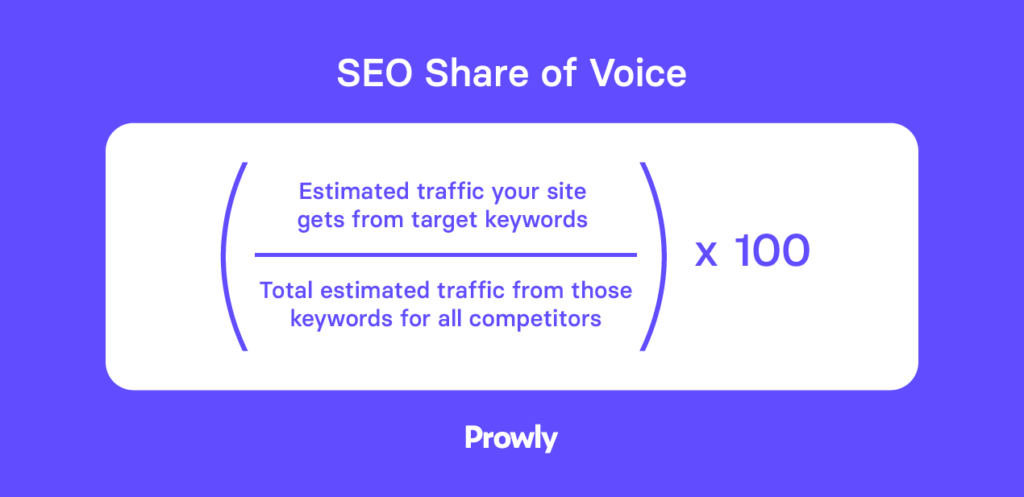
This gives you a percentage that reflects your presence and authority through organic search.
However, most businesses and SEO professionals use tools such as Semrush that are more accurate in measuring this metric.
Social media share of voice
Social media share of voice describes the percentage of the total social media presence you hold in your industry and in front of your target audience, as compared to your competitors and their social media accounts.
Social media SOV tracks social media mentions of your brand across platforms (like Twitter/X, Instagram, LinkedIn, Facebook, TikTok), as compared to the total mentions of your competitors or your entire industry. This often includes hashtags, tags, direct mentions, or keyword usage.
Market share vs. share of voice
Market share and share of voice are related, but they focus on different performance dimensions.
Market share is your portion of total sales volume in your industry. It reflects how much revenue your business makes compared to competitors. For example, if your company earns $10M in a $100M market, your market share is 10%.
Share of Voice (SoV) measures how visible your brand is across marketing channels, such as SEO, social media, or ads, compared to others. It’s about brand presence, not sales. If your brand has 20% of all mentions or impressions in your niche, that’s a 20% share of voice.
In short:
- Market share = financial performance
- Share of voice = brand visibility
While market share shows how much of the market you own, share of voice shows how much of the conversation you’re part of. A strong SoV often leads to increased market share over time.
Why you should measure Share of Voice
With so many different metrics for measuring your sales, PR, and marketing efforts, it seems like a chore to add SOV to your long list of things to report.
However, SOV can give you some extremely valuable insights.
- PR professionals measure share of voice online to gauge the effectiveness of their campaigns. Spotting increases in share of voice before and after a dedicated campaign helps point out successes and areas for improvement.
- They also use it to assess their general ranking in the competitive landscape.
- Comparing a brand's share of voice against other market players determines which brand is leading. It reveals what aspirational competitors to follow and which industry topics get the most engagement from your demographic.
- Finally, it indicates which brand is gaining on you and stands a chance of taking over your narrative.
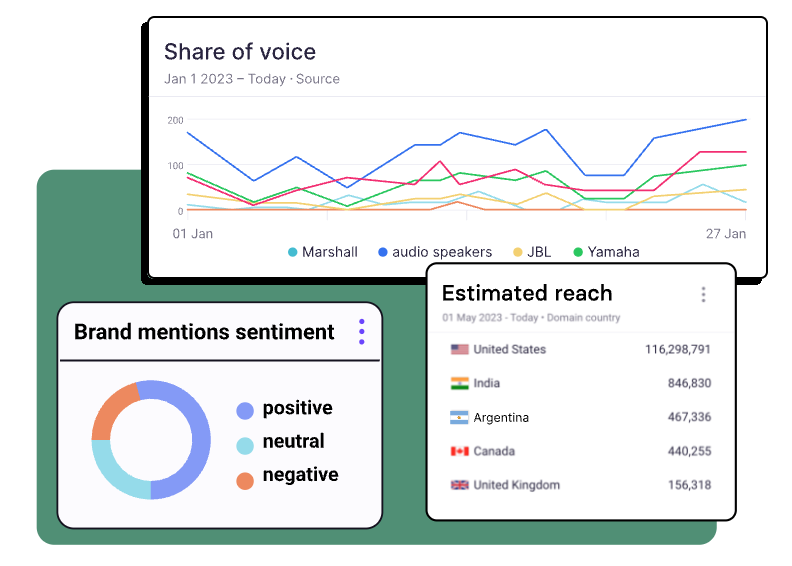
This share of voice calculation in competitive analysis essentially points out which brands are leading the pack, those setting their footprints on results pages or SERPs. This prompts your team to look into their latest marketing campaigns and decide whether the leading trends filling the hashtags are territory your brand should pursue.
How to calculate share of voice? Standard SOV formula
To appropriately calculate the share of voice, you'll first need to find two key details:
- The total online mentions for your brand name during a given period
- The total mentions of all brands in your market during the same time period
With this data, you can apply the most widely used share of voice formula:
(the total number of your brand's online mentions ÷ the total number of brand mentions in your market)
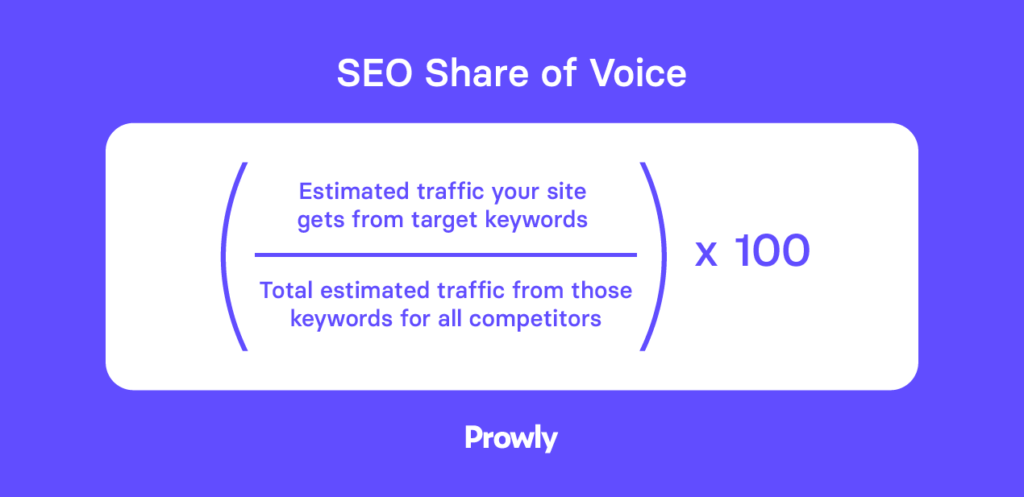
This allows you to understand the percentage of share of voice your brand has achieved in the chosen period, similar to calculations for impression share columns.
While the formula is simple, getting your hands on the calculation factors can be tricky. They involve searching and tallying mentions for your brand and all competing brands across multiple search engines and major social media networks.
Doing this manually is a huge effort, and ultimately, you'll be working with estimates. The output you create will be nothing short of an educated guess.
The best way to calculate share of voice, then, is to use a dedicated social listening tool such as Prowly that captures relevant keywords as they are mentioned in real time, all across the web and social media.
However, if you're committed to calculating your share of voice, you may want to ignore total market SOV altogether.
Instead, you may want to do a simple competitive analysis and focus on how many mentions you see against your closest competitor. You can use their total monthly mentions as a benchmark for your own brand mentions.
Don't forget sentiment analysis
Sentiment analysis means discovering how people feel when they talk about you online. Customer sentiment is a handy metric, especially if you can measure it with AI-based tools instead of doing it manually.
Along with reach and engagement, sentiment rounds out your brand's full online presence and gives you a complete picture of the discussion around your brand.
For example, an emerging PR crisis can be marked by a sharp increase in share of voice on LinkedIn or other platforms but with a purely negative sentiment. You'll want to know about this change as soon as possible.
The problem is that most companies won't notice if they suddenly get hundreds of negative mentions from LinkedIn or a similar platform. And by the time they notice, the crisis is in full swing, affecting everything from your brand reputation to your website traffic.
The key to solving this issue is using a PR platform such as Prowly that captures new mentions as they happen and uses AI to assign sentiment to each one. If Prowly spots a sudden spike in negative mentions, it alerts you to the possible crisis that may be brewing.
💡Read our guide about how to do media monitoring effectively and learn best practices and tips.
How do you know if your share of voice is good or not?
You may be wondering: What is a good share of voice percentage?
The problem is that we can't tell you because it depends on various factors. Your industry, the competitive landscape, your ongoing marketing and PR efforts, and so much more.
To determine whether your SOV is good, you need to measure it for a prolonged period of time. This means doing competitor research and seeing how your SOV comparea against others over time.
P.S. Here’s an article that might come in handy if you’re looking for a tool to measure the impact of your communication efforts.
The major benefit of Share of Voice tools
While share of voice is incredibly useful to capture, it also requires a lot of time and manual labor. In small businesses, agencies, marketing and PR teams, measuring SOV across various marketing channels manually just might not be possible.
But automated analytics tools, such as Prowly, can do the heavy lifting for you. Set up your keywords and campaign channels and you can monitor any particular brand that comes to mind - yours or your competitors.
Media monitoring tools can measure share of voice and conduct share of voice analysis, including sentiment analysis. Essentially becoming that SOV calculator you've been dreaming of.
Tip: check the scope of monitoring tools
Using tools for share of voice measurement saves time and provides real-time insights. Some of these tools can also perform sentiment analysis and track mentions across various media types.
Most of them track digital mentions and competitor metrics only: social media, review websites, blogs, online magazines, etc.
Although most of our information comes from online sources, print, TV, and radio remain crucial media platforms. They are often seen as more "prestigious" since earning mentions in these outlets is generally more challenging and securing press coverage in them boosts visibility and credibility.
Tools like Prowly give you the best of both worlds. They monitor digital and traditional media, including print monitoringand broadcasts, so you can:
- Easily analyze your results using customizable dashboards, complete with new filters that simplify evaluating the impact of your campaigns
- Ensure comprehensive coverage from diverse sources and evaluate print media investments and campaign ROI with advanced filters
Monitoring share of voice is best left to media monitoring tools. Among the tools used to measure share of voice is Prowly's PR automation software, which has handy SOV widgets.
💡 Tip: When choosing a media monitoring service, make sure it’s tailored to local media — for example, the UK market.
How do you calculate your share of voice with an automated PR tool like Prowly?
You don't have to calculate anything, because the tool does everything for you automatically.
Prowly's media monitoring tool simplifies share of voice calculation by:
- Tracking online mentions of your brand and your competitors.
- Using custom filters like media type, sentiment, backlinks, and languages.
- Tracking mentions in blogs, forums, print, and broadcast media.
- Providing various reporting graphs to visualize change over time.
Prowly tracks your share of voice across online media for you. More specifically, delivering the ability to:
- Focus on your competitors' brands and the keywords relevant to your company.
- Choose custom filters like media type, sentiment, backlinks, and languages.
- Track mentions in blog posts and in discussion groups like Reddit and Quora.
- Select your preferred type of reporting graph, like bar or donut, and even put insights on a timeline to visualize changes by the day.
- Track your brand experts and their current positioning, such as the number of times your CEO is mentioned alongside your brand.

Essentially, Prowly's media monitoring tool delivers the valuable SOV analysis you've been looking for.
It can easily calculate the number of times mentions occur for your brand and all competing brands.
Take a look at an example of Prowly's share of voice calculation to see how the data is organized:
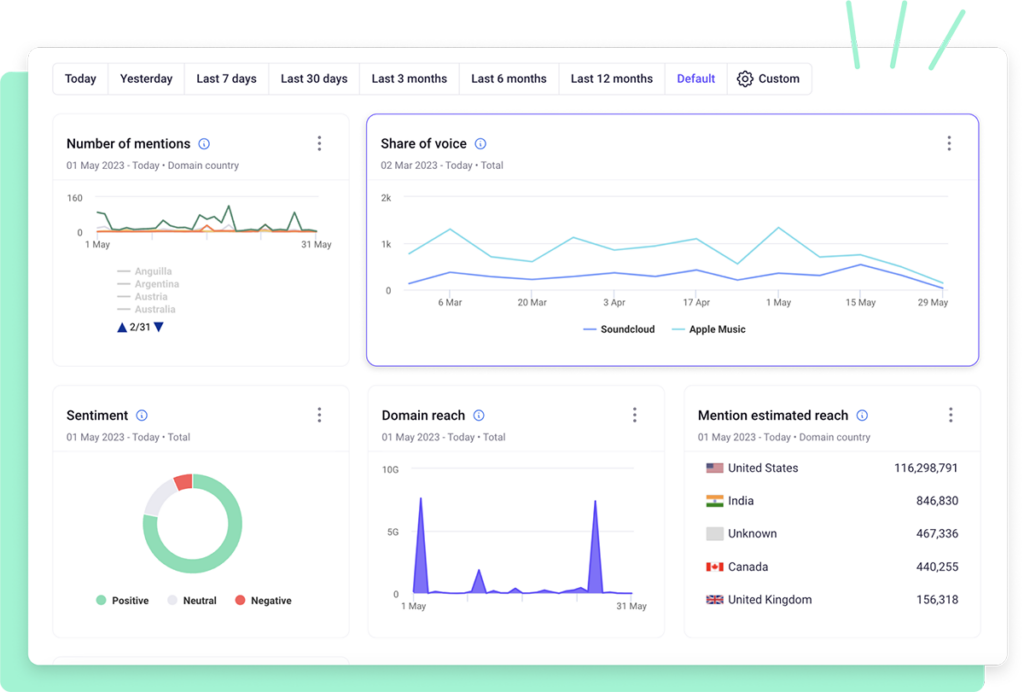
The best tools to measure share of voice for your brand
At this point, you hopefully know that tracking SOV across different marketing channels manually is nearly impossible. These are some of the best products to help you measure share of voice, online and offline.
1. Prowly (best overall for measuring SoV)
Pricing: Starts at $258/month with a free trial available.
Prowly is an all-in-one PR software solution that makes it easy to track media mentions, analyze coverage, and measure your brand’s share of voice in the press. It’s ideal for PR teams and marketers who want clear, actionable insights into how their brand is performing across editorial media.
Top features:
- Share of voice analytics that compare your brand to competitors in real time
- Media monitoring across online news outlets, blogs, and podcasts
- AI-powered coverage filtering to identify valuable mentions
- Automated reports that visualize trends, sentiment and SoV share
- Media database with access to over 1 million journalists and outlets
2. Brand24
Pricing: Starts at $99/month with a 14-day free trial.
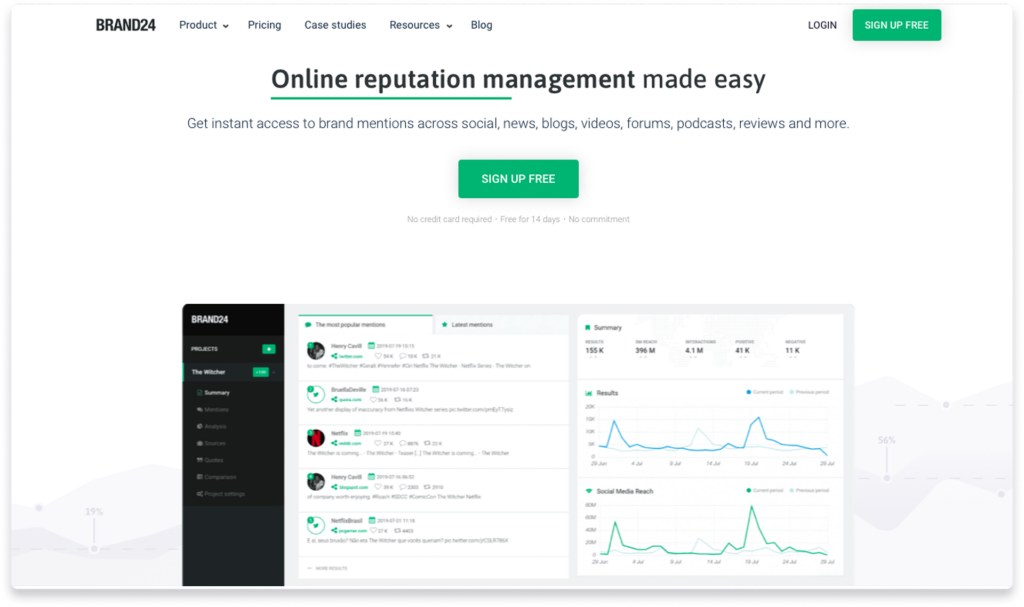
Brand24 is a social listening and media monitoring tool that helps you understand what people are saying about your brand online. It’s especially useful for tracking your social media share of voice, sentiment, and engagement over time.
Top features:
- Mentions tracking across social media, forums, news, and blogs
- Sentiment analysis to monitor brand perception
- Competitive comparison to benchmark your SoV against others
- Alerts and notifications for spikes in mentions or negative feedback
- Exportable reports for teams and clients
3. Semrush (best for measuring SEO SoV)
Pricing: Starts at $129.95/month with a 7-day free trial available.
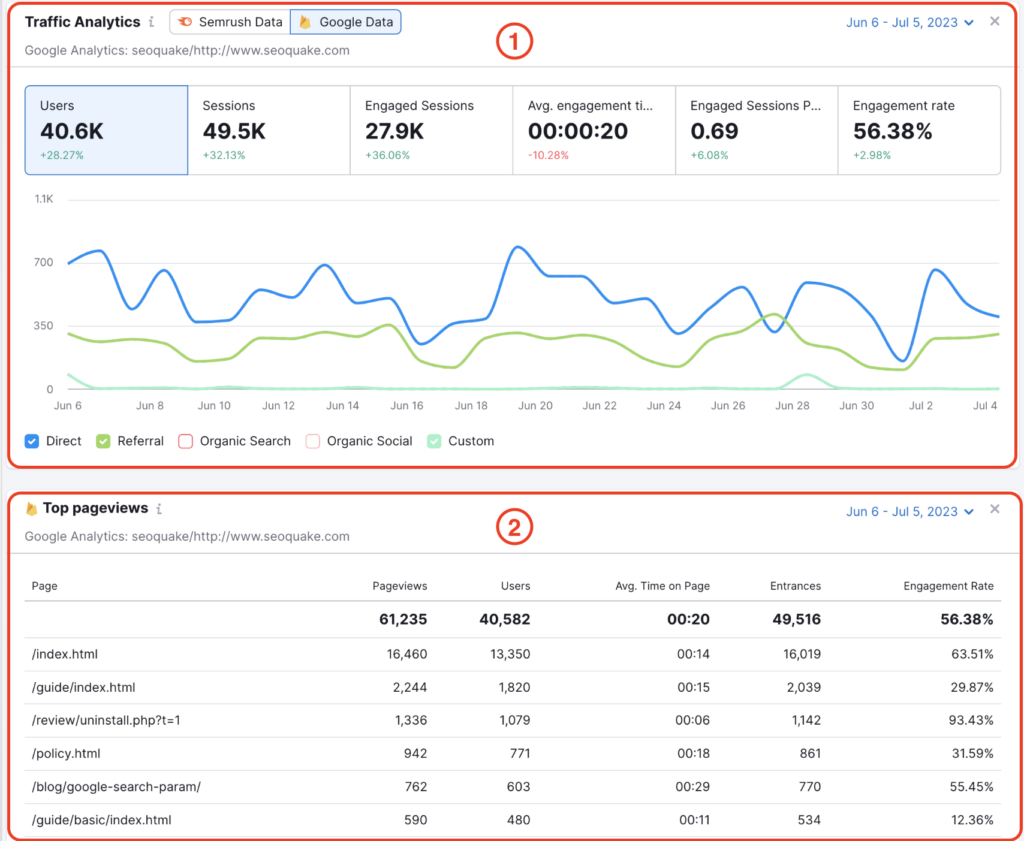
Semrush is a leading SEO and digital marketing platform and one of the best tools for tracking SEO share of voice. It allows you to see how your visibility in search compares to your competitors' across custom keyword sets.
Top features:
- Position tracking for specific keywords and domains
- SEO share of voice reports based on estimated traffic and rankings
- Competitive analysis to uncover keyword gaps and traffic share
- Organic research for visibility trends
- Custom dashboards to monitor changes over time
How to increase your share of voice in PR
So, you've either decided to manually calculate share of voice for your brand or you are using an automated tool to gather the data.
What comes next?
With these share of voice metrics in hand, you can now begin to strategize how to increase your share of voice measurement against the competition.
💡The time-tested tactics we recommend trying:
- Utilize your social media platforms and keep them up-to-date with frequent content that both provides value to your customers and nails your brand messaging home.
- Consistently add new SEO-rich blog posts to your website that focus on topics of importance for your current and potential customers.
- Engage regularly with customer comments, either on social media or in discussion forums, and engage with both positive and negative comments to build trust and loyalty.
- Reach out to the media consistently with exciting story pitches about topics getting attention in your market. Use an automated PR software tool to manage and deliver consistent media outreach.
- Run paid ad campaigns to supplement your earned media efforts and share of voice data. Keep brand messaging consistent.
- Share the expertise of your brand spokespeople, offering the media your brand leaders as experts in current trending topics.
- Get customers more involved with your brand. For example, conduct online polls where customers can help influence small company decisions like voting on the style of dress to manufacture for a new season.
When developing these strategies, note what messaging and content work best for your competitors. You may be able to create your own brand stories around these topics.
Looking for a way to measure your PR performance? Read our guide on PR Reporting: How to Measure Media Coverage.
Wrapping up
Share of voice is one of those brand metrics you can't ignore. It lets you not only compare yourself against the competition, but also against your previous performance. Unfortunately, measuring it is not for the weak of heart... If you do it manually.
With Prowly as your partner, we'll take care of the hard work so you can get SOV metrics with one click of a button. And that's just one of the many great PR features in Prowly.
Frequently asked questions
How to calculate share of voice in PR?
To calculate share of voice in PR, divide your brand’s earned media coverage by the total media coverage for all competitors in your industry, then multiply by 100.
Formula:
SOV (%) = (Your brand coverage / Total market coverage) × 100
This helps you understand how visible your brand is compared to others in your space.
What is a good tool for measuring share of voice?
Several tools can measure share of voice across media and digital channels. Popular platforms include Prowly, Brand24and SEMrush (for SEO share of voice). These tools track media mentions, sentiment, and visibility across news outlets, blogs, and social media.
What is an example of SOV analysis?
Typical SOV analysis might compare the media mentions of five brands in the same sector. For example, if your brand received 500 mentions in a month and your four competitors received 300, 100, 50, and 50 mentions respectively, your total market coverage is 1,000.
Your SOV = (500 / 1,000) × 100 = 50%
This means your brand had half of the media visibility in that space for that time period.

